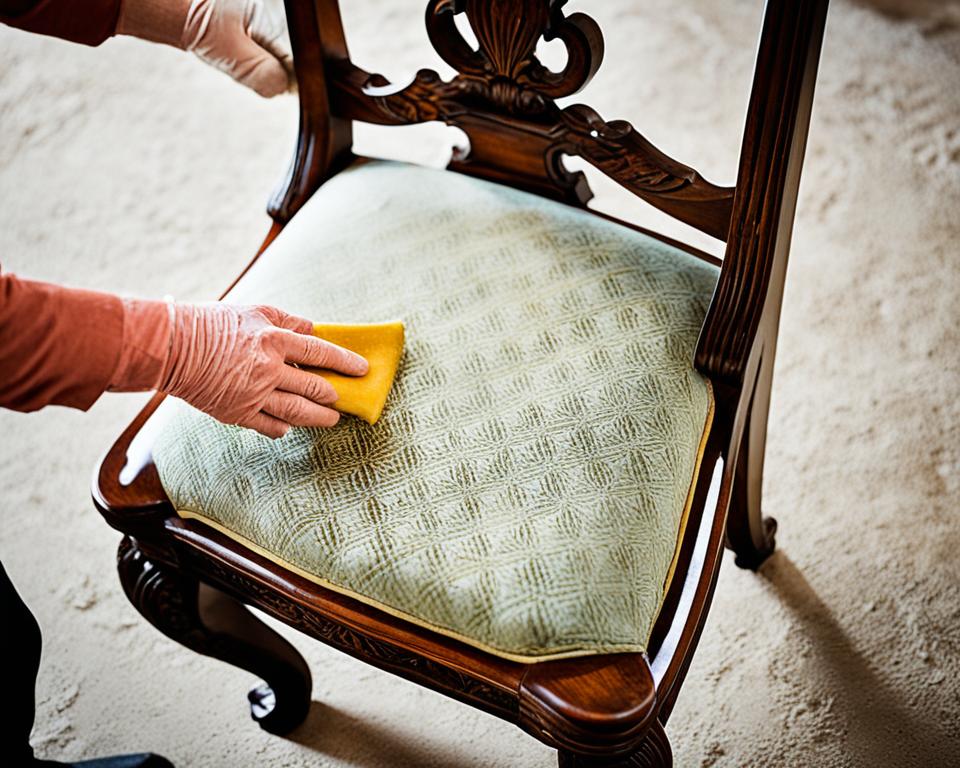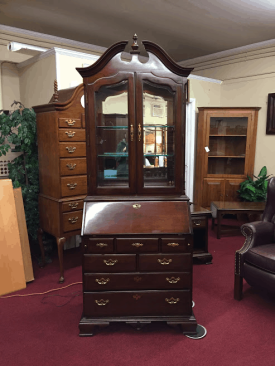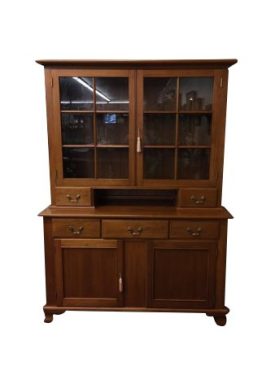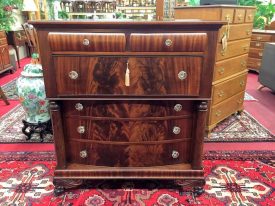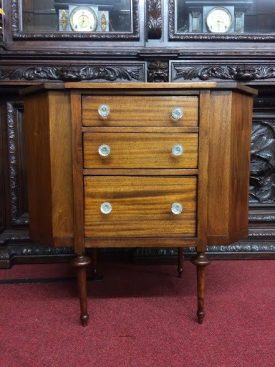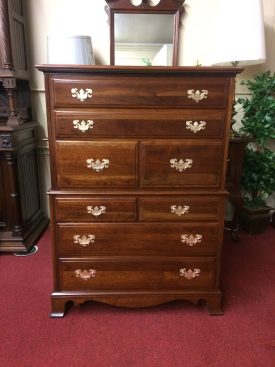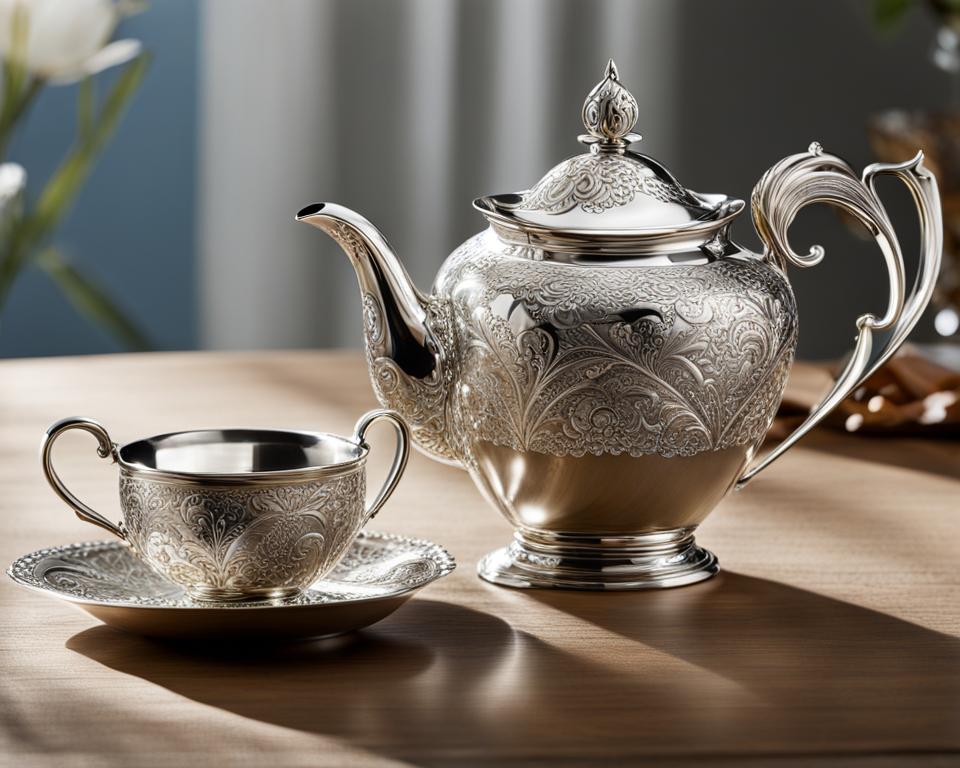Preserving your heirloom furniture is not only about maintaining its physical condition but also about safeguarding it as a cherished piece of family history. Whether it’s an antique dresser passed down through generations or a vintage dining table with sentimental value, proper care and maintenance are essential to ensure its longevity.
When it comes to heirloom furniture preservation, there are a few key considerations to keep in mind. From furniture restoration techniques to protecting it from environmental factors, these expert tips will help you maintain the beauty and integrity of your treasured pieces.
Key Takeaways:
- Heirloom furniture preservation is crucial to maintain its physical condition and sentimental value.
- Consult a conservator for any damage or restoration needs to respect the furniture’s integrity.
- Take precautions when moving heirloom furniture to prevent damage.
- Maintain a moderate environment with controlled temperature and humidity for long-term preservation.
- Protect your furniture from insects by regular inspection and professional treatment if necessary.
Respect the Integrity of Your Heirloom Furniture
Preserving the value of your heirloom furniture starts with respecting its integrity. It’s essential to avoid any remodeling or alterations that can compromise the originality and historical significance of the piece. Refrain from removing claw feet or painting wooden surfaces, as these modifications can diminish the authenticity and value of the antique furniture.
If your heirloom furniture is damaged or needs restoration, consulting a professional conservator is highly recommended. A conservator specializes in the preservation and conservation of historical artifacts and can assess the condition of your furniture, provide appropriate treatment, and ensure the utmost care is taken to maintain its integrity.
Locating a qualified conservator is made easier through local historical societies or the directory of the American Institute for Conservation of Historic and Artistic Works. These resources connect you with experienced professionals who have the expertise to handle and restore damaged or delicate heirloom furniture, ensuring its long-term preservation.
Remember, preserving the integrity of your heirloom furniture safeguards its historical and sentimental value, allowing future generations to appreciate its beauty and significance.
| Key Points |
|---|
| Avoid remodeling or altering the furniture |
| Consult a conservator for damaged furniture |
| Search local historical societies or conservation directories to find a qualified professional |
Moving Heirloom Furniture with Care
Moving antique furniture can be a delicate and challenging process. To ensure that your heirloom pieces arrive at their destination in pristine condition, it is essential to take the necessary precautions and protect them during the moving process.
Before you begin, it is important to remove any loose parts such as legs, finials, or chair arms. Wrap and box these parts separately to avoid damage during transportation. Additionally, take the time to pad corners, edges, and hardware with old towels or tissue paper to provide an extra layer of protection.
Enlisting help from friends or professional movers is highly recommended. Not only does this reduce the risk of injury to yourself, but it also ensures that the furniture is handled with care and expertise.
Prior to moving, it is crucial to measure doorways, stairways, and halls to ensure that the furniture can pass through without any difficulties. This step prevents the furniture from getting stuck or damaged during the moving process.
Remember, the key to moving heirloom furniture successfully is taking precautions and being meticulous throughout the process. By following these steps, you can safeguard your treasured pieces and enjoy them for years to come.
| Precautions when moving furniture: | Protecting furniture during moving: |
|---|---|
| Remove loose parts | Wrap and box separately |
| Pad corners, edges, and hardware | Use old towels or tissue paper |
| Enlist help | Prevent injury to yourself and furniture |
| Measure doorways, stairways, and halls | Ensure smooth passage without damage |
Maintaining Proper Environment for Heirloom Furniture
Preserving the condition and longevity of heirloom furniture requires maintaining a proper environment. It is crucial to keep the furniture inside the living area of your house, where temperatures and humidity are moderate. Fluctuating temperatures and humidity levels can have adverse effects on the furniture, such as causing the wood to dry out or absorb excess moisture, leading to loose joints and glue.
Avoid exposing the furniture to excessive light, whether natural or artificial, as it can damage the wood and upholstery over time. Sunlight, in particular, can cause fading and discoloration. To minimize exposure, consider using slipcovers and placing the heirloom pieces in darker areas of your home.
“Maintaining a moderate environment is crucial for preserving the beauty and integrity of heirloom furniture.”
By creating a controlled environment, you can significantly reduce the risk of damage and ensure the long-term preservation of your cherished heirloom pieces. Now, let’s take a look at the ideal temperature and humidity levels for furniture preservation:
| Temperature | Humidity |
|---|---|
| Between 68°F and 72°F (20°C and 22°C) | Between 40% and 55% |
Note: The table above outlines the recommended temperature and humidity range. However, it is important to consult with a furniture preservation specialist for specific recommendations based on the materials and conditions of your heirloom furniture.
Why is temperature important?
Extreme temperatures can cause significant damage to heirloom furniture. Excessive heat can lead to warping, cracking, or even melting of certain materials. On the other hand, extremely cold temperatures can also be detrimental, causing the wood to contract and potentially leading to damage.
The impact of humidity
Controlling humidity is equally important for furniture preservation. Excessively dry conditions can cause the wood to shrink, leading to loose joints and cracks. Conversely, high humidity levels can result in the expansion of wood and the growth of mold or mildew, which can irreparably damage the furniture.
In addition to maintaining a moderate temperature and humidity, it’s essential to monitor and regulate these conditions throughout the year. Using a hygrometer can help you keep track of humidity levels, and a thermostat can help maintain a consistent temperature in your home.
By taking these precautions and understanding the significance of a controlled environment, you can ensure the long-lasting beauty and functionality of your heirloom furniture.
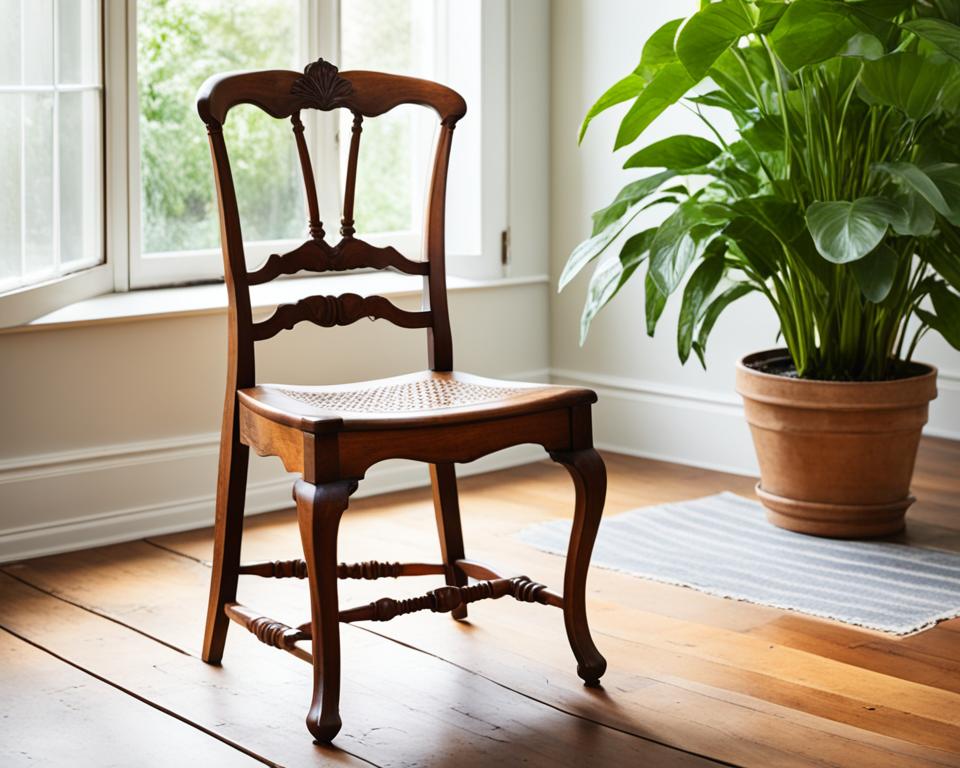
Protecting Heirloom Furniture from Insects
Insects can cause significant damage to heirloom furniture, compromising its beauty and structural integrity. To safeguard your cherished pieces from the perils of insect infestation, it is crucial to be proactive in prevention and vigilant in detection. By following these essential steps, you can protect your heirloom furniture for generations to come.
Inspect Regularly:
Periodically inspect your heirloom furniture for signs of insect activity. Look for telltale indications such as tunnels, small holes, droppings, or sawdust-like debris. Pay special attention to areas that provide an attractive habitat for pests, such as hidden corners, cracks, and crevices.
Prevention Measures:
To prevent attracting bugs, avoid eating or providing food sources near your heirloom furniture. Additionally, make a habit of cleaning any seams on tabletops thoroughly, as food particles or spills can easily accumulate in these areas and lure insects.
Professional Treatment:
If you suspect or confirm an infestation, it is crucial to take swift action. Contact a local exterminator experienced in treating insects that commonly target furniture. Professional intervention can effectively eradicate the pests, mitigating further damage to your precious heirlooms.
Quote:
“Preventing insect damage is key in preserving the longevity and beauty of heirloom furniture. Regular inspections and prompt action can save your cherished pieces from irreversible harm.” – Mary Thompson, Preservation Expert
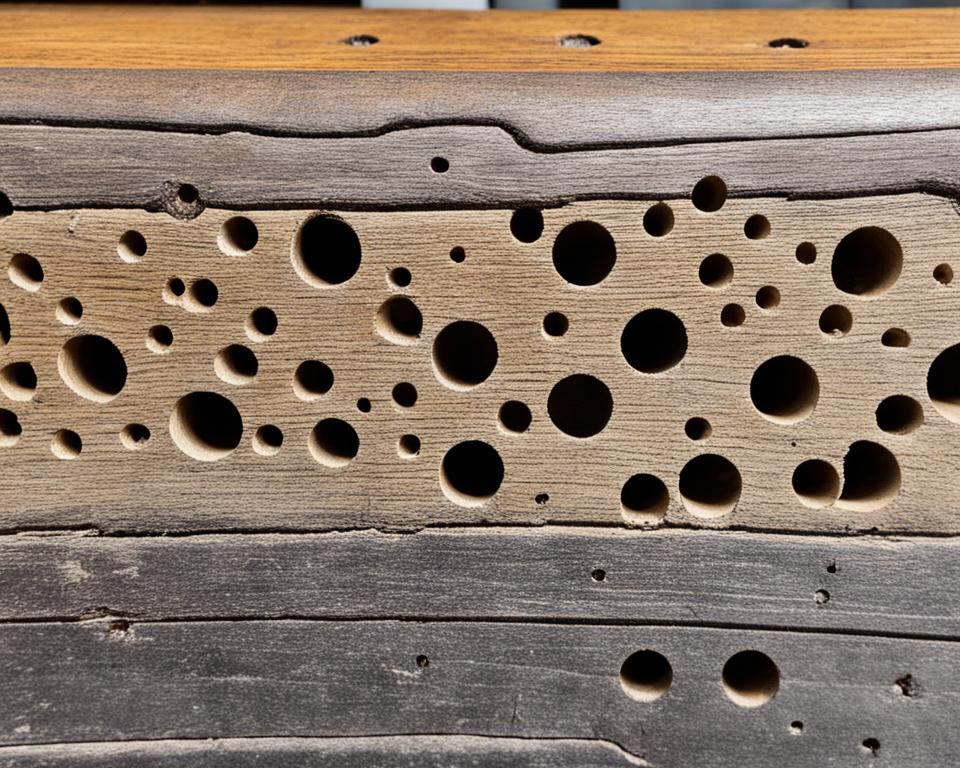
| Types of Insect Damage | Prevention | Treatment |
|---|---|---|
| Wood-boring Beetles |
|
|
| Termites |
|
|
| Silverfish |
|
|
Proper Cleaning and Maintenance for Heirloom Furniture
Preserving the beauty and lifespan of your heirloom furniture requires regular cleaning and maintenance. However, it’s essential to approach the task with caution to avoid causing any damage. Follow these expert tips to ensure the longevity of your cherished pieces.
Cleaning Antique Furniture
When it comes to cleaning antique furniture, it’s crucial to avoid using harsh cleaners or spray furniture polish. These products contain chemicals that can lead to a sticky residue or even damage the delicate wood finish. Instead, opt for a gentle approach:
- Dust your antique furniture regularly using a soft, lint-free cloth to remove any surface debris.
- For stubborn dirt or grime, dampen the cloth slightly with water or use a small amount of mild soap mixed with water.
- Always test any cleaning solution on a small, inconspicuous area of the furniture before applying it to the entire piece.
- After cleaning, ensure the furniture is completely dry before returning any decorative items or accessories.
Dusting Wooden Furniture
Wooden furniture, including antique pieces, requires regular dusting to maintain its appearance. Use a microfiber cloth or a soft brush to remove dust from crevices and carved details. Dust in the direction of the grain to avoid causing any scratches or damage to the wood.
Care for Woven Chair Seats
For furniture with woven chair seats, such as antique ladder-back chairs, take extra care when cleaning to preserve the integrity of the woven material. Here’s how:
- Use a vacuum cleaner with a soft brush attachment to gently remove dust and debris from the woven seat.
- If the woven seat is particularly dirty, you can also use a soft artist’s brush to brush away any stains or dirt gently.
- Avoid using any liquid cleaners or excessive moisture, as it can weaken or damage the woven material.
Cleaning Upholstery
Upholstered antique furniture requires special care to keep it looking its best. Follow these steps for cleaning upholstery:
- Regularly vacuum the upholstery using the upholstery attachment of a canister vacuum cleaner.
- Place a mesh screen over the fabric while vacuuming to prevent any pulls or damage to the fibers.
- If you notice any stains or spills on the upholstery, address them promptly using a mild upholstery cleaner recommended for the specific fabric type.
- Always blot stains gently with a clean cloth, avoiding rubbing or scrubbing, as it can further embed the stain into the fabric.
Leather Maintenance
Leather surfaces on antique furniture require proper care to maintain their luster and prevent any cracks or damage:
- Clean leather surfaces regularly using a soft, lint-free cloth lightly moistened with distilled water. Avoid using excessive water that can saturate the leather.
- Gently wipe the leather in a gentle circular motion to remove any surface dirt or dust.
- For stubborn stains, consult a professional conservator who specializes in leather restoration for the safest cleaning methods.
- To keep the leather supple and prevent cracking, apply a leather conditioner or preservative recommended by professionals.
| Do’s | Don’ts |
|---|---|
| Regularly dust antique furniture to prevent the build-up of debris. | Avoid using harsh chemicals or spray furniture polish. |
| Test any cleaning solution on a small, inconspicuous area first. | Never use abrasive materials or scrub aggressively. |
| Use a soft brush or microfiber cloth to dust wooden furniture. | Avoid exposing antique furniture to direct sunlight or excessive heat. |
| Consult a professional conservator for woven seat repairs. | Do not use liquid cleaners or excessive moisture on woven chair seats. |
| Vacuum upholstery regularly using a gentle attachment. | Do not rub or scrub stains on upholstery vigorously. |
| Clean leather surfaces with a soft, damp cloth. | Avoid using soap, acidic cleaners, or harsh chemicals on leather. |
Proper Storage for Heirloom Furniture
Preserving your heirloom furniture requires proper storage to protect it from potential damage. Avoid storing the furniture in the basement, as it can be susceptible to changes in temperature and moisture levels, which can negatively impact its condition. Additionally, storing it in the attic or garage may expose the furniture to extreme temperatures and humidity.
Instead, consider finding an out-of-the-way location within your home, such as a spare room, where the furniture can be stored safely. Alternatively, you can entrust a family member or trusted friend with the responsibility of storing your treasured heirlooms.
When storing the furniture, it is essential to ensure that it is adequately wrapped or covered to shield it from dust, dirt, and potential scratches. Utilize appropriate materials such as furniture blankets, bubble wrap, or acid-free paper to safeguard the surfaces. Moreover, take precautionary measures to protect delicate features, such as glass or intricate carvings, by carefully padding and securing them.
Additionally, choose a location with controlled temperature and humidity levels to maintain the furniture’s condition. Extreme temperature fluctuations and high humidity can cause irreparable damage to the wood and upholstery. Aim for a stable environment with moderate temperature and humidity levels to prevent warping, cracking, or mold growth.
Tips for Proper Furniture Storage
| TIP | Description |
|---|---|
| 1 | Choose a secure, out-of-the-way location |
| 2 | Use appropriate wrapping materials to protect the furniture |
| 3 | Pad delicate features to prevent damage |
| 4 | Ensure controlled temperature and humidity levels |
By taking these storage precautions, you can safeguard your heirloom furniture from potential harm and ensure its longevity for future generations to enjoy.
Documenting the History of Heirloom Furniture
Documenting the history of your heirloom furniture adds value and significance to these precious pieces. By diligently recording important details, you can preserve the provenance and authenticity of your family’s cherished possessions.
Begin by writing a comprehensive description of each piece, capturing important information about its origins and unique characteristics. Include details such as the previous owners, their locations, and how the furniture came into your possession. This documentation will provide future generations with valuable insights into the rich history of these heirlooms.
Remember to accompany the written description with a clear, high-quality photograph of each item. This visual record serves as a visual reference and helps to illustrate the unique features of the furniture in question.
To further enhance your documentation efforts, consider storing a copy of this information along with your estate files. By keeping all relevant details in one place, you can easily access and share this valuable information with family members and potential buyers in the future.
In addition to written descriptions and photographs, researching and deciphering manufacturer’s markings can unveil fascinating insights into the origins and craftsmanship of your heirloom furniture. Identifying and understanding these markings can provide important context, enabling you to better appreciate the craftsmanship and historical significance behind each piece.
“Researching manufacturer’s markings can unlock hidden stories within your heirloom furniture, revealing its place in the rich tapestry of history.”
As you delve into manufacturer’s markings, you may discover details about the furniture maker, production dates, or even regional influences. Such knowledge can help you estimate the value of your furniture and provide interesting anecdotes to share with future generations.
| Documenting the History of Heirloom Furniture | |
|---|---|
| Importance of written descriptions | ✔️ |
| Impact of accompanying photographs | ✔️ |
| Storing documentation with estate files | ✔️ |
| Unlocking insights through manufacturer’s markings | ✔️ |
Cherishing Heirloom Furniture with Sentimental Value
Heirloom furniture holds a special place in our hearts, carrying sentimental value that transcends its physical form. Passed down through generations, these cherished pieces become a part of our family’s history, weaving together tales of love, sacrifice, and tradition.
When exploring the origins of your heirloom furniture, consider delving into the treasure trove of old family photos. These snapshots offer glimpses into the past, providing valuable clues to help you identify specific heirloom pieces. Look for familiar furniture shapes, distinctive patterns, or unique features that match what you currently have in your possession.
Additionally, don’t hesitate to reach out to local relatives who may hold valuable information about the whereabouts of family furniture. They may have stories to tell or memories to share, allowing you to paint a vivid picture of your heirloom’s journey through time.
Take a moment to truly cherish and appreciate the sentimental value that these heirloom pieces bring to your home. Remember, they are not merely objects, but symbols of love, heritage, and enduring connections to your family’s past.
In preserving the legacy of your heirloom furniture, you have the opportunity to pass down both the physical and emotional aspects of these treasures to future generations. By doing so, you keep the flame of tradition alive, ensuring that the stories and memories held within these pieces continue to be cherished for years to come.
Conclusion
Preserving heirloom furniture is essential for ensuring that these valued family treasures can be enjoyed for generations to come. By following expert tips and guidelines for long-term furniture care, you can maintain the integrity of your heirloom pieces and protect them from environmental factors.
Respecting the integrity of the furniture is key. Avoid remodeling or altering your heirloom pieces, as such changes can diminish their historical and aesthetic value. Instead, consult a professional conservator if your furniture requires repair or restoration.
In addition to respecting the furniture’s integrity, it is crucial to protect it from environmental factors. Maintain a moderate environment with controlled temperature and humidity levels to prevent damage caused by fluctuations. Use slipcovers to shield the furniture from light exposure, and take measures to prevent insect infestation.
Cleaning and maintaining your heirloom furniture should always be done with care. Avoid using spray polishes or oils that can leave a residue or harm the finish. Follow specific care instructions for woven seats, upholstery, and leather surfaces to ensure they remain in excellent condition.
Proper storage is essential for long-term furniture preservation. Avoid basements, attics, or garages, as these areas can experience temperature and moisture fluctuations. Instead, find an out-of-the-way location inside your home with controlled temperature and humidity levels.
Lastly, documenting the history of your heirloom furniture and cherishing its sentimental value adds to its significance. Keep records of the furniture’s origins, including who owned it and how it came into your possession. By passing down these treasured family heirlooms, you can ensure that their legacy continues for years to come.
FAQ
How can I preserve my heirloom furniture?
To preserve your heirloom furniture, avoid remodeling or painting it. Consult a conservator for any damage or restoration needs. Take precautions when moving the furniture, and keep it in a moderate environment with controlled temperature and humidity. Use slipcovers and protect the furniture from light and insects. Dust regularly and avoid using spray polishes or oils. Follow specific care instructions for woven seats, upholstery, and leather surfaces. Proper storage is key, and don’t forget to document the history of your heirloom pieces.
How do I respect the integrity of my heirloom furniture?
To respect the integrity of your heirloom furniture, avoid remodeling or altering it. Consult a conservator if the furniture is damaged or needs restoration. You can find a conservator through a local historical society or the directory of the American Institute for Conservation of Historic and Artistic Works.
How can I move heirloom furniture with care?
Moving heirloom furniture requires careful handling to avoid damage. Remove loose parts and wrap them separately. Pad corners, edges, and hardware with old towels or tissue paper. Measure doorways, stairways, and halls before moving to ensure the furniture can pass through smoothly. Enlist help to prevent injury to yourself or the furniture.
What is the proper environment for preserving heirloom furniture?
To preserve your heirloom furniture, keep it in the living area of your house where temperatures and humidity are moderate. Fluctuating temperatures and humidity can damage the furniture. Avoid exposing it to light, natural or artificial. Use slipcovers and keep the furniture in dark areas to minimize exposure.
How can I protect my heirloom furniture from insects?
Periodically inspect your heirloom furniture for signs of insect infestation, such as tunneling, droppings, or sawdust. Avoid eating on the furniture and clean any seams on tabletops to prevent attracting bugs. If you suspect an infestation, call a local exterminator for treatment.
What is the proper cleaning and maintenance for heirloom furniture?
Avoid using spray furniture polish, oils, or modern cleaners on antique wood furniture. Instead, dust regularly and apply paste wax annually if needed. For woven chair seats, use a vacuum or a soft artist’s brush to remove dust. Clean upholstered furniture with the upholstery attachment of a canister vacuum and a mesh screen held against the fabric. For leather surfaces, clean with a soft, lint-free cloth moistened with distilled water, and consult a professional conservator for any restoration needs.
How should I store my heirloom furniture?
Avoid storing your heirloom furniture in the basement, attic, or garage, as these places can experience changes in temperature and moisture levels that can damage the furniture. Instead, consider storing it in an out-of-the-way location in a spare room or have a family member take it. Ensure that the furniture is adequately wrapped or covered and stored in a location with controlled temperature and humidity.
How can I document the history of my heirloom furniture?
Take the time to write down a description of each piece, including who owned it, where they lived, and how it came into your possession. Include a photo of the item and keep a copy with your estate files. Research manufacturer’s markings to learn more about the piece’s origins. This information can help in estimating the value of the furniture and may be required for insurance purposes.
How can I cherish heirloom furniture with sentimental value?
Look through old family photos for clues to identify specific heirloom pieces. Ask local relatives about the whereabouts of family furniture. Take time to cherish and appreciate the sentimental value of the furniture in your home. Consider keeping the tradition alive by passing down the heirlooms to future generations.

